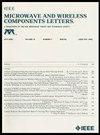用于双频带应用的垂直波导到微带的自偶极跃迁
IF 3.3
2区 工程技术
Q2 ENGINEERING, ELECTRICAL & ELECTRONIC
引用次数: 1
摘要
这封信提出了一种适用于双频带应用的新型垂直波导到微带的自双工转换。这一转变是通过标准的印刷电路板(PCB)制造工艺实现的,使其适合大规模生产和实际应用。将标准波导管拧在堆叠的顶部。双频带自双工操作是通过将两个微带(每个频带一个)通过H形槽耦合到两个辐射贴片来实现的。通过在辐射贴片之上添加两个寄生贴片,提高了工作带宽。金属化过孔用于在矩形波导和微带周围形成笼,以防止功率泄漏。已经制造了一个在K/Ka频带下工作的原型。实验结果表明,低频带和高频带的−10dB匹配带宽分别为20%和14%。在这些范围内,测量到的最大插入损耗分别约为0.6和0.7dB。本文章由计算机程序翻译,如有差异,请以英文原文为准。
Vertical Waveguide-to-Microstrip Self-Diplexing Transition for Dual-Band Applications
This letter presents a novel vertical waveguide-to-microstrip self-diplexing transition for dual-band applications. The transition is realized with standard printed circuit board (PCB) manufacturing processing, making it suitable for mass production and practical applications. A standard waveguide is screwed on the topside of the stack-up. Dual-band self-diplexing operation is achieved by coupling two microstrips (one for each band) to two radiating patches through H-shaped slots. The operating bandwidth has been enhanced by adding two parasitic patches above the radiating ones. Metalized via holes are used to form a cage around the rectangular waveguide and the microstrips to prevent power leakage. A prototype has been fabricated to operate at K/Ka frequency band. The experimental results show a −10 dB matching bandwidth of 20% and 14% for the lower and upper bands, respectively. Within these ranges, the maximum measured insertion loss is about 0.6 and 0.7 dB, respectively.
求助全文
通过发布文献求助,成功后即可免费获取论文全文。
去求助
来源期刊

IEEE Microwave and Wireless Components Letters
工程技术-工程:电子与电气
自引率
13.30%
发文量
376
审稿时长
3.0 months
期刊介绍:
The IEEE Microwave and Wireless Components Letters (MWCL) publishes four-page papers (3 pages of text + up to 1 page of references) that focus on microwave theory, techniques and applications as they relate to components, devices, circuits, biological effects, and systems involving the generation, modulation, demodulation, control, transmission, and detection of microwave signals. This includes scientific, technical, medical and industrial activities. Microwave theory and techniques relates to electromagnetic waves in the frequency range of a few MHz and a THz; other spectral regions and wave types are included within the scope of the MWCL whenever basic microwave theory and techniques can yield useful results. Generally, this occurs in the theory of wave propagation in structures with dimensions comparable to a wavelength, and in the related techniques for analysis and design.
 求助内容:
求助内容: 应助结果提醒方式:
应助结果提醒方式:


